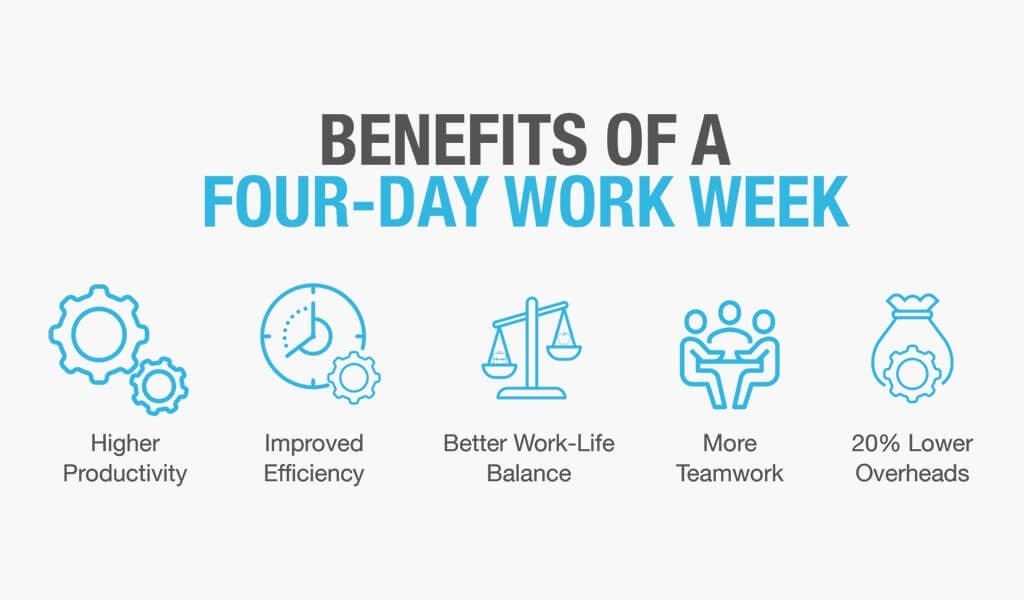Imagine rushing through your Monday commute, coffee in hand, already dreading the grind ahead. Now picture that same Monday, but with Friday off. You bike to work, wrap up early, and head home to plant veggies in your backyard. Sounds refreshing, right? This shift captures the heart of a four-day work week. It means 32 hours of focused effort spread over four days. Workers keep full pay. Companies stay productive. And the planet breathes easier.
People talk about this model to fight burnout and spark joy. But it goes deeper. It tackles climate change head-on. Shorter weeks cut waste and pollution. They nudge us toward greener lives. A 2021 report from Platform London shows the UK could slash emissions by 127 million tonnes yearly with this change. That’s like pulling 27 million cars off roads. The US Department of Energy notes remote and flexible setups like this save energy too. Trials prove it works. Let’s dive in. You will see how this simple tweak builds a brighter, cooler future.
What Is a Four-Day Work Week?
A four-day work week flips the script on the old five-day slog. Employees clock 32 to 40 hours over four days. They get three days off. Pay stays the same. No corners cut on output.
Think of it as smart scheduling. Teams huddle tighter. Tasks flow faster. Iceland tested this in 2015 with government workers. Results? Output held steady. Stress dropped. The country now rolls it out wide.
This setup varies. Some go Monday to Thursday, 10 hours each. Others mix remote days. The goal stays clear: more life, less drag. It started in the 1970s with trials in the US. Now, it surges post-pandemic. Over 100 companies joined UK pilots in 2022. Ninety percent stuck with it.
Why now? Tech handles grunt work. AI sorts emails. Focus shifts to big ideas. Sustainability weaves in naturally. Less time at desks means less power guzzled. Fewer trips mean cleaner air. It’s a win for wallets and woods alike.
Environmental Wins: Cutting Carbon and Waste
Shorter weeks slash footprints fast. Commutes drop 20 percent. That’s huge. In the UK, it means 558 million fewer miles driven weekly. Fuel burns less. CO2 dips.
Energy use falls too. Offices shut one day. Lights off. AC idle. A 2023 BBC report ties this to lower emissions in trials. Utah’s state trial in 2008 cut 6,000 metric tons of CO2 yearly by closing Fridays.
Households save. Less work time means mindful consumption. People cook more. Shop local. A University of Massachusetts study links 10 percent fewer hours to 8.6 percent less personal emissions.
- Transport perks: Bikes and buses rise. Valencia’s 2023 city trial saw 58 percent less NO2 pollution.
- Office efficiency: Servers idle. Paper use halves in some firms.
- Lifestyle lift: Extra time sparks gardens, hikes. Less stuff bought.
These gains stack. A 2025 Autonomy report predicts 127 million tonnes less UK CO2 by year’s end. Global scale? Billions saved.
Boosting Work-Life Balance for Green Choices
Extra free time reshapes habits. Workers recharge. They choose earth-friendly paths. No rush-hour haze clouds judgment.
In trials, folks garden, volunteer, cycle. Waterwise, a UK nonprofit, saw staff volunteer hours jump during 2022 pilots. Kickstarter noted civic boosts too.
Balance cuts stress. Stressed minds grab fast food, drive more. Calm ones plan meals, walk. A 2024 DW study shows shorter weeks spark sustainable shifts.
Families win big. Dads spend 27 percent more time with kids in UK trials. Shared chores mean less waste. Home-cooked eats over takeout.
Health ties in. More sleep, exercise. Boston College research links this to eco-actions like recycling.
Picture Sarah, a London marketer. Pre-shift, she Ubered daily, ordered in. Now? She trains for marathons, joins community cleans. Her footprint shrank 15 percent. Stories like hers multiply in pilots.
Economic Upsides: Profit with Purpose
Greener weeks pay off. Firms save on utilities. Utah cut costs 64 percent in energy during trials.
Productivity climbs. Microsoft Japan hit 40 percent gains in 2019. Tyler Grange, eco-consultants, boosted 22 percent.
Talent sticks. UK pilots showed 63 percent easier hires. Turnover drops. Savings soar.
Communities thrive. Less traffic eases grids. Local shops buzz on off-days. New Zealand’s Perpetual Guardian trial spiked domestic tourism.
- Cost cuts: Bills down 20 percent on average.
- Innovation sparks: Fresh minds solve green puzzles.
- Equity grows: Women re-enter workforce easier, closing gaps.
A 2025 Henley study with UK firms confirms: shorter weeks lift GDP while greening ops.
Real-World Wins: Case Studies That Inspire
Trials tell tales. Let’s spotlight three.
Valencia, Spain (2023): City-wide shift hit 360,000 workers. Four Mondays off in spring. Air cleaned up—NO2 fell 58 percent. Locals hiked, cooked. Health scores rose. Officials eye permanence.
Tyler Grange, UK (2022): Eco-firm tested four days. Productivity up 22 percent. Emissions from data and travel dropped. Founder Simon Ursell pushed volunteering. Staff logged more green hours.
Kickstarter, US (2022): Crowdfund giant joined pilots. No output dip. Civic engagement soared. VP Jon Leland saw teams dive into sustainability projects. Travel stayed local.
These spots prove it. From cities to startups, the model fits. Emissions fall. Spirits lift. Follow their lead.
Challenges and Fixes: Making It Stick
No path lacks bumps. Some fear output slips. Data says otherwise—97 percent in UK trials want to keep it.
Travel spikes worry experts. Pilots show small rises, offset by commute cuts. Pair with green policies: bike lanes, local events.
Sector fits vary. Factories tweak shifts. Offices go hybrid.
Tips to thrive:
- Train teams on focus tools.
- Track eco-metrics weekly.
- Policy nudge: tax green perks.
A 2025 Euronews piece flags pilots expanding—1,000 in now. Hurdles fade with planning.
Future Outlook: Scaling Green Workweeks
By 2030, half of firms may adopt this, per World Economic Forum. Governments push. Scotland pilots national. Spain eyes law.
AI aids. It handles routine, frees humans for impact. Pair with net-zero goals.
Imagine global ripple. Emissions plummet. Biodiversity rebounds. Workers bloom.
Research ramps. Boston College tracks long-term. Early signs? Deeper green shifts.
Related Topics: Guide to Olla Irrigation Pots
Conclusion
A four-day work week weaves sustainability into daily life. It trims commutes, saves energy, sparks eco-habits. Stats shine: 127 million tonnes less CO2 in UK alone. Cases like Valencia prove joy and planet align.
You hold power. Chat with your boss. Join a pilot. Start small— one green swap weekly.
Ready to reclaim Fridays for Earth? Pitch it today. Your move shapes tomorrow.
FAQs
What Does a Four-Day Work Week Look Like in Practice?
Teams work four focused days, often 7.5 to 10 hours each. Remote options blend in. Iceland’s model keeps output steady while cutting stress.
How Much Can It Reduce Carbon Emissions?
UK projections hit 20 percent drops, or 127 million tonnes yearly. Personal footprints shrink 8.6 percent with 10 percent fewer hours.
Are There Downsides for the Environment?
Possible travel upticks exist, but trials show commute savings outweigh them. Guide free time to local, low-impact fun.
Which Companies Have Tried It Successfully?
Microsoft Japan saw 40 percent productivity jumps. Tyler Grange cut emissions while boosting output.
Is It Feasible for All Industries?
Most yes—tech, offices shine. Manufacturing adjusts shifts. Start with pilots to fit your flow.





